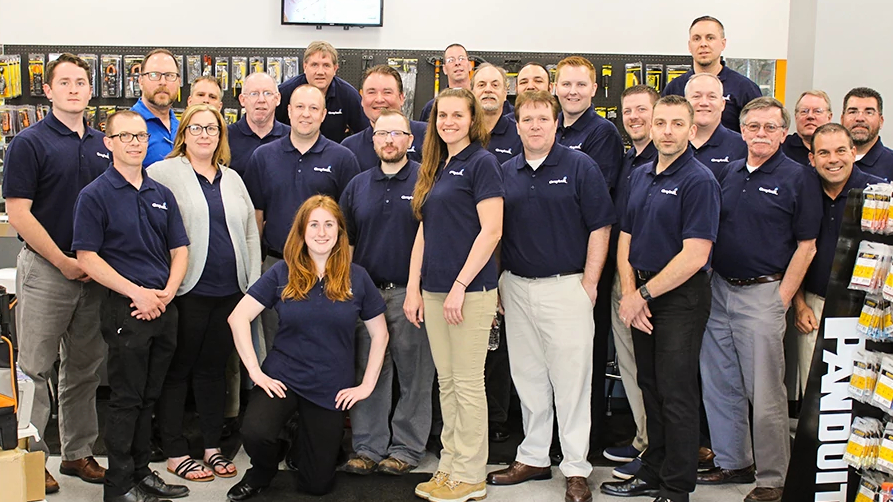Taking Ownership: An Overview of Employee Ownership at Graybar
Graybar is an employee- and retiree-owned, FORTUNE 500 distributor of electrical, communications and data networking products, based in St. Louis, Missouri. The company has more than 8,200 employees, 292 locations across North America and $7.3 billion in annual revenue (2020).
Graybar became employee owned in 1929 and remains one of the oldest and largest employee-owned companies in North America. Read on to learn more about Graybar’s employee ownership story and how it shapes the company and its culture.
Graybar’s employee ownership journey
Graybar traces its history back to 1869, when Enos Barton and Elisha Gray founded a small telegraph manufacturing company called “Gray and Barton.” This company eventually became Western Electric, a large and influential manufacturer of electrical and telephone equipment. Over time, Western Electric built a successful Supply Department, which sold products from many other manufacturers. This Supply Department was spun off as a separate subsidiary in 1925, named Graybar in honor of its original co founders, Gray and Barton.
Western Electric put the new company up for sale, but there were strings attached. Graybar would not be sold unless the purchaser agreed to maintain the company’s generous pension, health and other employee benefit programs. Many investors were interested, but there were no buyers…except for Graybar’s employees.
When Graybar employees purchased the company from Western Electric, it made history as one of the first large, employee-owned corporations in the U.S. In fact, it was front-page news when Western Electric’s President, Edgar Bloom, made the announcement on November 5, 1928.
On Jan. 1, 1929, Graybar became an independent, employee-owned corporation. It was initially capitalized at $9 million — $3 million raised by the sale of stock to Graybar employees, and $6 million in non-voting, redeemable preferred stock held by Western Electric. Graybar paid dividends on and eventually redeemed the shares held by Western over time, including during the Great Depression, making the final redemption payment in 1941.
To this day, Graybar remains 100 percent owned by its active and retired employees and continues to embrace the principles of employee ownership that were established 92 years ago.
How does employee ownership at Graybar work?
Graybar’s ownership structure is truly unique. Active Graybar employees and qualified retirees can choose to buy shares of stock when they are offered in a public offering at $20 a share, typically once a year. If employees leave Graybar before they are eligible to retire, they must sell their shares to the company at the same price. Retirees can hold on to their shares and continue to collect any dividends that may be declared. The estates of employees or retirees must sell the shares to the company within one year of their passing, also at $20.
Most Graybar shareholders elect to deposit their shares into a voting trust, which authorizes trustees to vote on their behalf for certain matters that require shareholder approval. However, the voting trustees’
power is limited, and they do not have the ability to sell or transfer any stock that has been entrusted to them.
While the purchase price of Graybar shares never changes, the company has paid discretionary cash dividends every quarter since 1929, resulting in an annual cash rate of at least 10 percent every year since 1941. The board of directors may also choose to pay occasional stock dividends. As a result, the company’s stock has provided an average annual total return well above 10 percent.
The decision to purchase and hold Graybar shares is voluntary and, subject to the terms and conditions of a given offering, available to most regular, full-time employees who meet minimum service requirements—from front-line employees to senior executives. With more than 7,000 shareholders, Graybar stock is owned by such a large number of people that no one person or group controls more than 1 percent of the power to dispose of the stock at any time. This helps to foster an environment in which all shareholders have the same long-term interests.
How ownership influences Graybar’s culture
Many things have changed since Graybar became employee owned in 1929, but the company’s values remain the same. Throughout its history, the core values of Integrity, Employee Ownership, Long-Term View and Customer Focus have been the foundation for Graybar’s success. These values are not just words, but principles that honor the company’s rich heritage and influence the way employees work together every day.
Graybar strives to build a culture where employees feel a true sense of ownership for their results and can share in the success of the company. Communication is a priority, which helps employees stay informed on the company’s performance and connected to its strategy. Graybar asks employees for feedback through regular surveys and inspires creative thinking through its employee innovation program. The company also offers a wide range of benefits and other advantages that help employees live well today and plan well for the future.
Giving back is a core part of Graybar’s employee ownership culture. The company encourages employees to donate their time, talents and resources to strengthen their local communities by providing community time off and matching employee donations to select charities. In addition, Graybar employees generously help each other in times of need through the Graybar Family Foundation, an independent nonprofit organization that provides support to employees facing unexpected hardships. With this kind of culture, it’s no surprise that Graybar has earned recognition as a top workplace nationally and listed among the FORTUNE World’s Most Admired Companies for 19 years.
Quite simply, employee ownership works for Graybar. While the company has a long track record of success, its employees continually strive to raise the bar for their customers, their communities and each other. They take a personal interest in Graybar’s long-term success, and they keep moving forward to achieve accelerated growth and transformation for the future.
To learn more about Graybar, visit Graybar.com.

